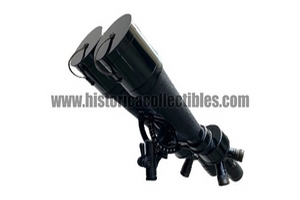Doppelfernrohr "ASEMBI" Carl Zeiss, Kriegsmarine Artillery, circa 1935
Doppelfernrohr or Double Telescope model "ASEMBI" made by Carl Zeiss around 1935.
This extraordinary double telescope was installed on board the large warships of the Kriegsmarine as demonstrated by the acceptance mark of the German Navy, consisting of the Reichsadler and "Artl." (Artillerie), used mainly from 1933 to 1935 until it was replaced with the Eagle with Swastika. It was built mainly in solid iron which made it considerably heavy but this was considered a necessary requirement to be able to withstand the impacts of the very strong explosions caused by the batteries of the powerful guns on board the battleships and heavy cruisers.
Its optical equipment is composed of two turrets with 3 eyepieces each, with 12x, 20x, and 40x respectively, orthoscopic eyepieces or triplets, suitable for brighter focal ratios, with an excellent reduction of aberrations but above all of distortions; they combined with 80mm lenses were considered the best for the optical properties they had, allowing the observer to view incredibly bright and sharp images.
Two small "levers" placed near the turrets allowed you to lock or unlock the rotation on the chosen magnification. Furthermore, the interpupillary opening of the eyepieces obtained by rotating the two turrets to the maximum distance was arranged in such a way as to allow the use of the binoculars even by two observers at the same time.
What makes this binoculars unique is their eyepieces which are structurally built with evident aesthetic and mechanical differences compared to all other known Asembi models. It is considered probable that this example, together with a few others, was created not only for the purpose of observation but also as an aiming device useful for shooting at ships.
These extraordinary technological innovations will make it an optical-mechanical excellence that is still unsurpassed today when compared to the era in which it was produced.
You can appreciate some images where this Doppelfernrohr is in use by officers and observers on board Kriegsmarine ships.
The binoculars are in excellent aesthetic and functioning condition, all the mechanisms move correctly and are perfectly collimated.
Carl Zeiss takes its name from its founder, Carl Zeiss, who on November 17, 1846 chose the small town of Jena, in Thuringia, as the location for his precision optical equipment factory. Thanks to the severe quality control that Carl Zeiss imposed on his products, going so far as to personally destroy the microscopes that did not pass the tests, the newly formed Zeiss became the official supplier of the University of Jena and received the gold medal of the industrial exhibition in 1861 of Thuringia as the best research instrument produced in Germany, awarded to the Stand I microscope of 1857.
In 1866 the thousandth microscope was produced and the name Zeiss became known throughout European scientific circles. Thanks to studies on the Porro prism, in 1893 Abbe patented double prism binoculars, which accentuated the perception of depth.
The mass production of Zeiss binoculars began in 1894, already at the beginning of the twentieth century more than 30,000 were made, at the beginning of the First World War the quota had risen to 500,000 and, at the end of the Second World War, as many as 2,260,000 were produced binoculars for the civil and military market.
Models were made starting from 4x11 mm to 12x40 mm, up to real giants such as the 80 mm and 100 mm. Thanks to studies conducted on the perception of light in low light situations, it was demonstrated that the average dilation of the pupil in an adult is approximately 7 mm.
For this reason, the 7x50 mm model was introduced in 1910 and remained on the market until 1917 with few changes to the materials used. In 1926, following the post-war crisis of the First World War with the Treaty of Versailles which bankrupted many important German companies, Zeiss purchased "C.P. GOERZ" and founded Zeiss Ikon in 1926.
In 1937 Zeiss had commercial contacts and factories in more than 29 countries around the world. From '33 Zeiss acquired interest from the Nazi regime, which balanced production towards military instruments. It successfully produced binoculars with wide-angle optics for military use, pressure-resistant optical systems for U-boats, periscope binoculars for targeting tanks. Furthermore, Zeiss cameras were mounted on the V2s for remote sensing operations of the English coasts.
On 1 November 1935, Zeiss, in the figure of Alexander Smakula, patented a process for the treatment of optical glass with extraordinary results in terms of light transmission. Remained a military secret until 1939, it was adopted on binoculars to reduce ghost images and internal reflections.
During the Second World War, there were numerous bombings against the Zeiss factories. Jena was bombed several times by the Allies starting in 1944.
Stuttgart was razed to the ground, although the Contessa-Nettel factory suffered little damage. The bombing of Dresden, in addition to devastating the city, also caused considerable damage to the Zeiss Ikon headquarters.
On April 13, 1945, American military forces entered Jena, surprising themselves that the bombing had not caused any significant damage. The main planetarium was in ruins, while the factories remained operational.



